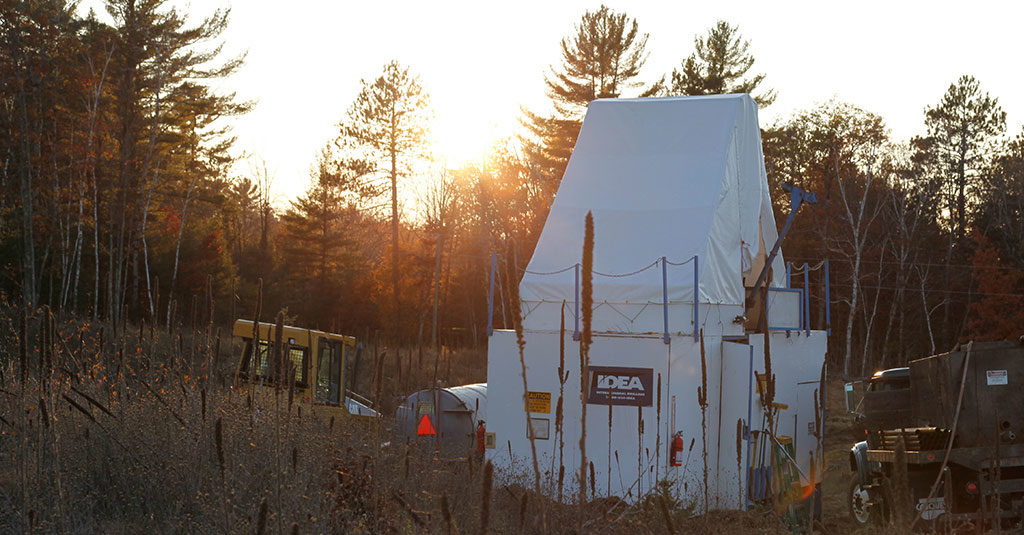Aquila Resources has announced the results of an independent open pit only feasibility study completed on its 100% owned zinc- and gold-rich Back Forty project in Michigan, USA. The study was compiled by Lycopodium Minerals Canada with support from globally recognized experts and specialist consulting engineering companies in environmentally critical areas such as waste water treatment, tailings and waste rock management and mine design. All economic values within this news release are in US dollars unless indicated otherwise.
“The completion of the Back Forty Project Feasibility Study is a significant milestone for Aquila and sets the stage for the next steps to develop this deposit,” said Barry Hildred, President and Chief Executive Officer of Aquila. “Back Forty is well-positioned as a permitted project in a favourable mining jurisdiction that is close to existing infrastructure. We can now focus the company’s resources on the pre-construction phase at Back Forty while considering funding alternatives to complete the development of the project.”
Highlights
- Pre-tax NPV at a 6% discount rate of $259 million and IRR of 32.0% at base case metal prices of $1,300/oz gold, $1.20/lb zinc, $20/oz silver, $3.00/lb copper and $1.00/lb lead
- After-tax NPV at a 6% discount rate of $208 million and IRR of 28.2% with a 2.2 year payback
- Open pit Proven and Probable Mineral Reserves of 11.65 Mt
- A project life of seven years with total payable gold production of 468,000 oz (or an average of 67,000 oz/y) and 135,000 oz in Year 1. Total payable gold equivalent production of 1.1 Moz
- Total payable zinc production of 512 Mlb (or an average of 73 Mlb/y). Total payable zinc equivalent production of 1,200 Mlb
- Initial project capital costs estimated at $294 million with a 24-month construction period
- Sustaining capital costs of $110.6 million
- Gross C1 cash costs1 of $499/oz gold equivalent or $0.46/lb zinc equivalent and net C1 cash costs of -$590/oz gold or -$1.73/lb zinc
- Gross AISC2 of $677/oz gold equivalent or $0.62/lb zinc equivalent and net AISC of -$171/oz gold or -$1.34/lb zinc
- The company has also identified a number of opportunities to further enhance the overall economics of the project including the future addition of an underground expansion.
Andrew Boushy, Senior Vice President, Projects commented, “I want to thank our entire expanded team of specialists and consultants for all of their efforts in helping us complete the feasibility study. The robust results of the study clearly demonstrate that Back Forty is a compelling project based only on an open pit operation and we see several opportunities to further enhance value that will be advanced during the detailed engineering phase. We have set the bar high for environmental protection and plan to engage local contractors who live in the community in which we will operate.”
The Back Forty project is a polymetallic (zinc, gold, copper, silver, lead) Volcanogenic Massive Sulphide (VMS) deposit located in Menominee County, Michigan, USA. The Back Forty deposit was originally discovered in 2002, and is currently wholly-owned by Aquila. It is located approximately 55 km south-southeast from Iron Mountain, and approximately 19 km west of Stephenson, Michigan.
Mineralization at the Back Forty deposit consists of discrete zones of: 1) zinc or copper-rich massive sulphide (±lead), which may contain significant amounts of gold and silver, 2) stockwork stringer and peripheral sulphide, which can be gold, zinc, and copper-bearing (±lead/silver), 3) precious metal-only, low-sulphide mineralization, and 4) oxide-rich, precious metal-bearing gossan.
Major aspects of the project include mine open pit, hydrological cut-off wall, oxide and sulphide processing plants, tailings management facility, waste rock storage facilities, contact and non-contact water basins, mine services, access road and a state of the art waste water treatment plant. The reclamation and closure plan includes the backfilling of the open pit with waste rock and the capping of the tailings and waste rock facility followed by a minimum of 20 years of environmental monitoring as required by Michigan law.
Access to the facility is from the west side of the project from the existing River Road. Principal access will be via a main security gate near the process plant. Power to the site will be provided via an incoming high voltage line from the east side of the project.











